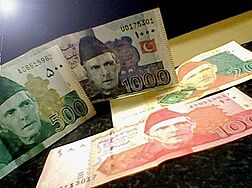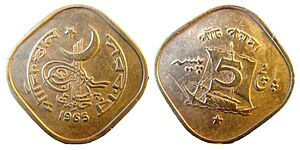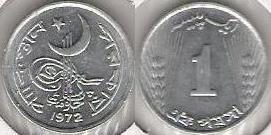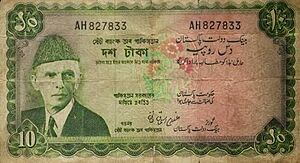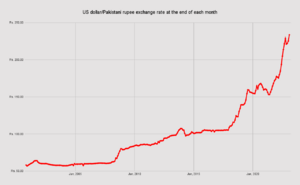Pakistani rupee facts for kids
Quick facts for kids Pakistani rupee |
|||
|---|---|---|---|
|
|||
| ISO 4217 Code | PKR | ||
| Official user(s) | |||
| Unofficial user(s) | |||
| Inflation | 11.8% (May 2024) | ||
| Subunit | |||
| 1⁄100 | Paisa (defunct); Paisa denominated coins ceased to be legal tender in 2013 |
||
| Symbol | Re. /- | ||
| Coins | |||
| Freq. used | Re. 1/-, Rs. 2/-, Rs. 5/- | ||
| Rarely used | Rs. 10/- | ||
| Banknotes | |||
| Freq. used | Rs. 10/-, Rs. 20/-, Rs. 50/-, Rs. 100/-, Rs. 500/-, Rs. 1,000/-, Rs. 5,000/- | ||
| Rarely used | Rs. 75/- | ||
| Printer | Pakistan Security Printing Corporation | ||
The Pakistani rupee (its ISO code is PKR) is the official money used in Pakistan. The State Bank of Pakistan is in charge of printing and controlling this money. Pakistan officially started using the rupee in 1949.
Before 1949, the Reserve Bank of India managed the coins and notes. Then, the governments of India and Pakistan agreed to transfer this control to Pakistan's government and its State Bank.
In Pakistan, people count large amounts of rupees using a special system. For example, a "lakh" means one hundred thousand. A "crore" means ten million. Even with these terms, numbers are still written with commas every three digits, like 123,456,789.
Contents
History of the Pakistani Rupee


The word rūpiya comes from an old Sanskrit word. It means "wrought silver" or "a silver coin". The word was first used to describe a coin introduced by Sher Shah Suri between 1540 and 1545 CE.
When Pakistan became independent on August 14, 1947, a special order was made. It said that the Reserve Bank of India would temporarily manage money for both India and Pakistan. This was supposed to last until September 30, 1948. During this time, Indian money was still valid in Pakistan.
The order also allowed Indian notes to have "Government of Pakistan" written on them. These special notes started circulating in Pakistan from April 1, 1948. Like the Indian rupee, the Pakistani rupee was first divided into 16 annas. Each anna was worth 4 pice or 12 pie.
For the first seven months after Pakistan's creation, Indian money was still used. Then, modified Indian notes were introduced. These notes had "Government of Pakistan" written on them in English and Urdu.
In early 1948, India and Pakistan agreed to change the plan. The Reserve Bank of India's role as Pakistan's money manager ended earlier, on June 30, 1948.
In January 1961, Pakistan changed its money system to a decimal system. This meant one rupee was now divided into 100 "pice". Later that year, these were renamed "paise" (one "paisa"). However, coins smaller than one rupee, like paise, have not been made since 1994.
In 1972, when Bangladesh became independent, it introduced its own money, the Bangladeshi taka. It was worth the same as the Pakistani rupee at first. After that, the Pakistani rupee was no longer used in Bangladesh.
Pakistani Coins
In 1948, Pakistan started making its own coins. These included values like 1 pice, half, 1, and 2 annas, and quarter, half, and 1 rupee. In 1951, 1 pie coins were added.
When the money system changed in 1961, new coins were made. These were for 1, 5, and 10 pice. Later that year, 1 paisa, 5, and 10 paise coins were released. In 1963, 10 and 25 paise coins came out, followed by 2 paise coins in 1964.
One rupee coins were brought back in 1979. Two rupee coins came out in 1998, and five rupee coins in 2002. The 2 paise coins were last made in 1976, and 1 paisa coins stopped in 1979. All 5, 10, 25, and 50 paise coins stopped being made in 1996.
In 2007, the 1 and 2 rupee coins were changed to be made of aluminum. In 2013, coins smaller than one rupee (paisa coins) were no longer valid. This made the 1 rupee coin the smallest money you could use.
On October 15, 2015, Pakistan released a new 5 rupee coin. It was smaller, lighter, and golden in color. In 2016, a 10 rupee coin was also put into circulation. In 2019, a special 50 rupee coin was made to celebrate the 550th birthday of Guru Nanak.
| Coins you can use today | ||||||
|---|---|---|---|---|---|---|
| Obverse | Reverse | Value | Years in use | What it's made of | Picture on the front | Picture on the back |
| Re. 1/- | 1998 – present | Bronze (1998–2006) Aluminium (2007–present) |
Quaid-e-Azam, Muhammad Ali Jinnah |
Hazrat Lal Shahbaz Qalandar Mausoleum, Sehwan Shareef |
||
| Rs. 2/- | 1998 – present | Brass (1998–1999) Nickel-brass (1999–2006) Aluminium (2007–) |
Crescent and Star | Badshahi Masjid, Lahore | ||
| Rs. 5/- | 2002 – present | Cupronickel (2002–2011) Copper-Zinc-Nickel (2015–present) |
Crescent and Star | Number "5" | ||
| Rs. 10/- | 2016 – present | Nickel-brass | Crescent and Star | Faisal Mosque, Islamabad | ||
| For table standards, see the coin specification table. | ||||||
Pakistani Banknotes
On April 1, 1948, temporary banknotes were issued for Pakistan. These notes were made by the Reserve Bank of India and the Government of India. They were only for use in Pakistan. These notes had "GOVERNMENT OF PAKISTAN" written on them in English and Urdu.
The United Kingdom's Thomas De La Rue and Company, along with Bradbury Wilkinson and Company, also printed different banknotes for Pakistan.
After Pakistan became independent, it set up its own printing facility in 1949. It was called the Pakistan Security Printing Corporation (PSPC). This company was a partnership between Thomas De La Rue & Co. and the Pakistani Government. They chose a special printing method to make it harder to copy the notes.
Regular government banknotes started in 1948. These were for 1, 5, 10, and 100 rupees. The government kept printing 1 rupee notes until the 1980s. The State Bank of Pakistan took over printing other notes in 1953. They issued 2, 5, 10, and 100 rupee notes.
Fifty rupee notes were added in 1957. Two rupee notes were brought back in 1985. In 1986, 500 rupee notes were introduced, followed by 1,000 rupee notes the next year. The 2 and 5 rupee notes were replaced by coins in 1998 and 2002.
Twenty rupee notes were added in 2005, and 5,000 rupee notes in 2006. Before 1971, Pakistani banknotes had writing in both Urdu and Bengali. This was because Bengali was an official language in East Pakistan (which is now Bangladesh).
The PSPC started printing its own 1 and 5 rupee notes in 1952-53. These notes looked similar to the ones printed by Thomas de la Rue & Company. The 1 rupee note had a new blue back.
On December 14, 1963, the State Bank of Pakistan began running its own printing press. It eventually took over all national banknote production.
In 2024, Pakistan announced plans for new banknotes of all values. These new notes will have different colors, new serial numbers, and special security features. The change will happen slowly. The central bank also plans to introduce a new plastic banknote later this year. If people like it, more plastic notes might be made.
Features of Banknotes
All banknotes, except for the 1 and 2 rupee notes, have a picture of Muhammad Ali Jinnah on the front. They also have writing in Urdu. The back of the banknotes has different designs and English text. The only Urdu text on the back is a saying: "Seeking an honest livelihood is an act of worship." This is written as حصول رزق حلال عبادت ہے.
The banknotes come in different sizes and colors. Larger value notes are longer. Each note has a main color, but they also have many other colors. All banknotes have a watermark for security. On larger notes, the watermark is a picture of Jinnah. On smaller notes, it is a crescent and star. Each banknote also has different types of security threads.
List of Banknotes
| Banknotes before the 2005 series | ||||||
|---|---|---|---|---|---|---|
| Image | Value | Dimensions | Main color | What's on the back | Status | |
| Obverse | Reverse | |||||
| Re. 1/- | 95 × 66 mm | Brown | Tomb of Muhammad Iqbal in Lahore | Not used anymore | ||
| Rs. 2/- | 109 × 66 mm | Purple | Badshahi Masjid in Lahore | |||
| Rs. 5/- | 127 × 73 mm | Burgundy | Khojak Tunnel in Balochistan | |||
| Rs. 10/- | 141 × 73 mm | Green | Mohenjo-daro in Larkana District | Not used anymore | ||
| Rs. 50/- | 154 × 73 mm | Purple and red | Alamgiri Gate of the Lahore Fort in Lahore | |||
| Rs. 100/- | 165 × 73 mm | Red and orange | Islamia College in Peshawar | |||
| Rs. 500/- | 175 × 73 mm | Green, tan, red, and orange | The State Bank of Pakistan in Islamabad | Not used anymore | ||
| Rs. 1,000/- | 175 × 73 mm | Blue | Tomb of Jahangir in Lahore | |||
The State Bank has started a new series of banknotes. They are replacing older designs with new ones that have better security.
| Image | Value | Dimensions | Main colour | Description | Date of | Ref. | ||||||
|---|---|---|---|---|---|---|---|---|---|---|---|---|
| Obverse | Reverse | Obverse | Reverse | Watermark | issue | withdrawal | lapse | |||||
| Rs. 5/- | 115 × 65 mm | Olive and grey | Muhammad Ali Jinnah | Gwadar Port | Muhammad Ali Jinnah and "5" | 8 July 2008 | 31 December 2011 | 31 December 2012 | ||||
| Rs. 10/- | 115 × 65 mm | Olive | Bab-e-Khyber (entrance to the Khyber Pass) | Muhammad Ali Jinnah and "10" | 27 May 2006 | Current | ||||||
| Rs. 20/- | 123 × 65 mm | Burgundy | Mohenjo-daro | Muhammad Ali Jinnah and "20" | 13 August 2005 | Current | ||||||
| Orange | 22 March 2008 | Current | ||||||||||
| Rs. 50/- | 131 × 65 mm | Purple | K2 | Muhammad Ali Jinnah and "50" | 8 July 2008 | Current | ||||||
| Rs. 100/- | 139 × 65 mm | Red | Quaid-e-Azam Residency | Muhammad Ali Jinnah and "100" | 11 November 2006 | Current | ||||||
| Rs. 500/- | 147 × 65 mm | Green | Badshahi Mosque | Muhammad Ali Jinnah and "500" | 11 November 2006 | Current | ||||||
| Rs. 1,000/- | 155 × 65 mm | Blue | Islamia College in Peshawar | Muhammad Ali Jinnah and "1000" | 26 February 2007 | Current | ||||||
| Rs. 5,000/- | 163 × 65 mm | Brown | Faisal Mosque | Muhammad Ali Jinnah and "5000" | 27 May 2006 | Current | ||||||
| For table standards, see the banknote specification table. | ||||||||||||
Special Banknotes
In 1949, Pakistan put rules in place about taking money in and out of the country. This was to stop smuggling. But pilgrims going on Hajj to Saudi Arabia needed money. So, Pakistan started printing special Hajj notes for them. These notes had "For pilgrims from Pakistan for use in Saudi Arabia and Iraq" printed on them.
The government decided to use these special notes because many pilgrims could not read. Also, other ways of exchanging money would have cost too much. The State Bank allowed these Hajj notes to be issued in May 1950.
A new series of Hajj notes came out in 1972. They had "For Haj [sic] pilgrims from Pakistan for use in Saudi Arabia only" printed in both Urdu and English. New notes were printed in 1975 and 1978. Hajj notes were used until 1978. After that, most of the remaining Hajj notes were destroyed.
Pakistan has also issued special banknotes to celebrate important events. For example, notes were made for the 50th and 75th anniversaries of Pakistan's independence. The 75th anniversary note was an unusual 75 rupee value.
| Hajj banknotes | |||||
|---|---|---|---|---|---|
| Image | Value | Main colour | What's on the back | When it was used | |
| Obverse | Reverse | ||||
| Rs. 10/- | Dark purple | Shalimar Gardens in Lahore | 1960–1969 | ||
| Rs. 10/- | Dark blue | Mohenjo-daro in Larkana | 1970–1976 | ||
| Rs. 100/- | Dark orange | Islamia College (Peshawar) | 1970–1976 | ||
| For table standards, see the banknote specification table. | |||||
| Special banknotes for Pakistan's 50th and 75th Independence anniversaries | ||||||
|---|---|---|---|---|---|---|
| Image | Value | Main colour | What's on the front | What's on the back | When it was used | |
| Obverse | Reverse | |||||
| Rs. 5/- | Dark purple | Quaid-e-Azam Muhammad Ali Jinnah | Baha-ud-din Zakariya Tomb Multan | 1997 | ||
| For table standards, see the banknote specification table. | ||||||
| Value | Dimensions | Main colour | Description | Date of issue | Ref. | |||
|---|---|---|---|---|---|---|---|---|
| Obverse | Reverse | Watermark | ||||||
| Rs. 75/- | 147 × 65 mm | Green | Muhammad Ali Jinnah, Muhammad Iqbal, Fatima Jinnah, Syed Ahmad Khan | Markhor, Deodar tree | Muhammad Ali Jinnah and "75" | 30 September 2022 | ||
| Rs. 75/- | 139 × 65 mm | Blue | Muhammad Ali Jinnah, Building of the State Bank of Pakistan | Fatima Jinnah | Muhammad Ali Jinnah and "75" | July 2023 | ||
| For table standards, see the banknote specification table. | ||||||||
Exchange Rate of the Rupee
From 1948 to July 1955, the Pakistani rupee was linked to the U.S. dollar. About 3.31 rupees were equal to one U.S. dollar. Then, in 1955, the rupee was devalued, meaning it became worth less. After this, about 4.76 rupees were equal to one U.S. dollar. This fixed rate stayed until May 11, 1972, when the rupee was devalued again to 11 rupees per dollar.
At first, the Indian and Pakistani rupees were worth the same. But in 1949, the British pound lost value, and India also devalued its currency. Pakistan did not. This made the Pakistani rupee worth 44% more than the Indian rupee. This changed in 1955 when Pakistan devalued its rupee, making it equal to the Indian rupee again.
Since 1971, the Pakistani rupee has been a fiat money. This means its value is not linked to gold or any precious metal. Before 1971, the rupee's value was fixed to the U.S. dollar for international trade.
In 1982, the government changed to a "managed float" system. This meant the rupee's value could change more freely. As a result, the rupee lost 38.5% of its value between 1982 and 1988. This made imported goods more expensive and hurt Pakistan's economy.
The Pakistani rupee continued to lose value against the United States dollar until the early 2000s. Then, Pakistan had a lot of extra money from trade, which made the rupee's value go up. The State Bank of Pakistan then bought dollars to keep the rupee's value stable. This helped Pakistan's exports stay competitive.
The year 2008 was tough for the rupee. Between December 2007 and August 2008, it lost 23% of its value. It reached a very low point of 79.20 rupees to one U.S. dollar. This happened because Pakistan had large trade deficits. Also, problems in some areas of Pakistan made foreign investment drop.
The rupee kept slowly losing value until early 2018. Then, it started to drop much faster. The situation got worse in mid-2021. The Pakistani rupee lost almost half its value between May 2021 and May 2023. This was mainly due to political problems, severe floods, and a debt crisis.
However, the Pakistani rupee gained value from late September to mid-October 2023. This happened after Pakistan's Federal Investigation Agency cracked down on illegal dollar trading. Since then, the Pakistani rupee has been one of the best-performing currencies against the U.S. dollar.
| Current PKR exchange rates | |
|---|---|
| From Google Finance: | AUD CAD CHF EUR GBP HKD JPY USD RUB |
| From Yahoo! Finance: | AUD CAD CHF EUR GBP HKD JPY USD RUB |
| From XE.com: | AUD CAD CHF EUR GBP HKD JPY USD RUB |
| From OANDA: | AUD CAD CHF EUR GBP HKD JPY USD RUB |
| From fxtop.com: | AUD CAD CHF EUR GBP HKD JPY USD RUB |
See also
 In Spanish: Rupia pakistaní para niños
In Spanish: Rupia pakistaní para niños
- Currency
- Rupee
- History of the rupee
- Economy of Pakistan
- List of countries by leading trade partners


